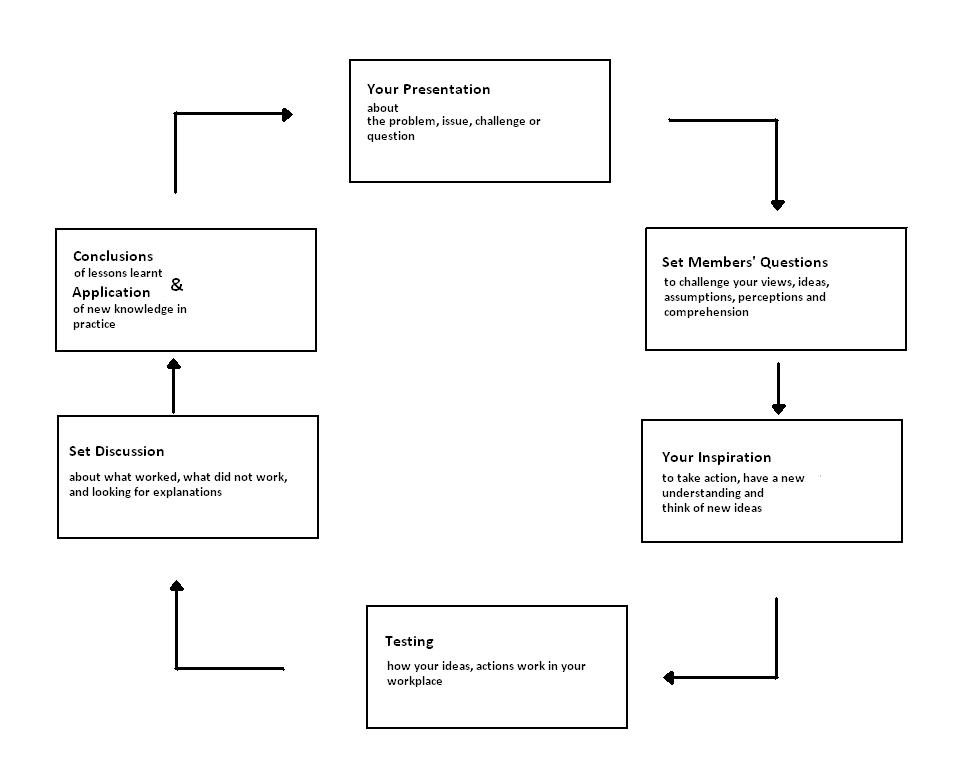General Guidelines
- Keep the number of participants low. There is likely to be an optimum size depending on the objective the group is intended to work on. Usually four is the minimum number of participants, while eightis the maximum size.
- Consider carefully how to establish the membership. When the membership decision is made by the Action Learning Set itself it will have strengths related to identity. However free choices may be dangerous when used as a unique strategy.
- Give the group part of the objectives, letting them the freedom of discussing the remaining ones. It can be useful to give the group the possibility to decide how they will demonstrate that they reached the expected results, helping them to balance between over-ambition and under-achievement.
- Suggest the leadership in the set to be rotated. This means that different members can take the lead for different tasks and contribute to the overall result.
- Suggest the group to consider both positive and negative experiences. Since Action Learning Sets are about learning from experiences, episodes where some errors were encountered and did not give positive results are as useful as the ones where everything worked fine.
- Help the Action Learning Set to track its work. The members should keep records of what has been discussed during the meetings. This can be useful for an assessment of the results obtained.
Key components
- A problem (urgent, significant, complex, relevant, without an easy solution);
- An Action learning team (diverse, with diversified experienced, selected by pre-determined criteria);
- A process of insightful questioning & reflective listening;
- An action taken on the problem (initiated and implemented by the group);
- A commitment to learning (learning is the ultimate goal, not merely finding a solution);
- An Action Learning Coach (facilitator, enabler, support,).
Participant's Rules
- Take responsibility of your learning and actions;
- Collaborate with other members;
- Listen actively, telling people if you have problems in understanding;
- Be honest and open to yourself and to the other members;
- Keep the details of what was discussed during the set confidential;
- Speak for yourself without generalizations;
- Respect everyone's right to speak or not to speak;
- Make statements only in response to questions;
- Ask questions;
- Commit to the process.
Facilitator's Role
- Create a safe space where to have honest discussions;
- Remind participants of the methodology of the set and keep the discipline;
- Model helpful questioning;
- Be a good listener;
- Draw attention to the issues of process;
- Be conscious of time;
- Follow the same rules as the participants, since he/she is not there to take decisions for the others.
- Ask key questions especially at a point when intervention is necessary (e.g.: participants get stuck, there is a need for clarification, a good learning opportunity);
- Promote ongoing reflection;
- Sense and navigate the emotions of the participants in order to achieve the desired results effectively.
Action Learning Sets can become auto-facilitating, but this should be done only when the participants got experienced in the methodology.
Step by Step
Group members meet regularly over a reasonable time period (every 4-6 weeks). An Action Learning Program generally previews 6 meetings.
Before the Meeting
- Each participant has to think about the work-based issues he/she would like to bring into the set and to agree on setting aside all the time that will be necessary.
During the Meeting
- As the meeting starts, the facilitator should explain to the participants the ground rules and the basic principles of the Action Learning Sets.
- One participant then has the opportunity to an “airtime”, introducing the issue to be shared with the others. This is composed of two parts:
- The first one is an uninterrupted speech where the person has to outline the issue.
- The second part is a question and answer session that involves all the other members of the meeting.
- Once the “airtime” is over, the person presenting the issue is invited to give feedback to the group on the way he/she experienced the process and what were the lessons learned.
- The person presenting the issue should also make a commitment to a specific action to take, according to the suggestions and the various behaving possibilities discussed with the other participants.
- The “airtime” is then given to other members of the set, trying to leave space to as many participants as possible.
- Before closing the meeting, an agreement on the logistic details of the following meeting should be reached.
- All the following meetings will start dedicating some time to the people that discussed their issue in the previous set, asking them to report back to the group on their actions since the last meeting.[2]
After the Meeting
- An After Action Review should be completed once the meeting is concluded. Its aim is to capture the key learning points and action plans discussed during the meeting.
Summary of the Action Learning Process

Job Aid
 Organizing an Action Learning Set Organizing an Action Learning Set |
